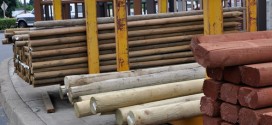To view a PDF of this story, click here and to see additional photos from The New American Home, click here.
New House On the Block
All photos Courtesy of Jeffery A. Davis Photography
Every year, home design preferences shift, technology evolves and homeowners’ tastes change. This means that home designers, builders and contractors are responding to these trends as well, making it more important than ever for home improvement retailers to stay ahead of the curve when it comes to building materials and supplies.
In January, Hardware Retailing attended the National Association of Home Builders’ (NAHB) annual event and the International Builders’ Show (IBS), both part of Design and Construction Week®, in Las Vegas to find trends and talk to industry experts. Attendees included builders, remodelers, designers and other housing industry professionals. (Get a closer look of the show.)
In addition to the Las Vegas Convention Center, attendees could travel to Henderson, Nevada, to tour The New American Home (TNAH) 2016, which is the “official show home” of IBS.
Hardware Retailing spoke with NAHB’s Tucker Bernard, director of The New American Home program, to ask about the top building and design trends in the home.
The purpose of TNAH is to demonstrate building best practices, including concepts, materials, designs and construction techniques that can be replicated—in whole or in part—in housing built or remodeled in any place and in any price range, according to Bernard.
Through this article, we’ll take you on a tour of the home, where we’ll highlight innovations in home construction and building materials. We’ll also provide tips on how to best incorporate and sell these trends in your lumber and building materials offerings.
We’ll focus on three aspects of TNAH to note: the touch of luxury throughout the home; individuality represented through customization; and a stronger focus on innovations that bring technology and energy-efficiency standards to the forefront.
 Focus on Luxury
Focus on Luxury
Full-View Windows and Doors
If your operation offers windows and doors, you may want to look closer at the growing popularity of full-view options. This was seen throughout the model home as well as on the floors of IBS by several window and door manufacturers.
According to Bernard, more consumers than ever are leaning toward these types of high-end windows and doors throughout the home, which is a good sign for the industry.
“Homeowners’ growing preference for using luxury home products is a noteworthy trend,” Bernard says. “It indicates a top-down recovery from the home building and remodeling industry, with higher-end products disproportionately increasing in use compared with the use of average-price and economy products.”
Retailers who focus on lumber and building materials should know contractors and DIYers may hunt for more floor-to-ceiling window and door options that let in natural light.
As you promote full-view windows and doors, remember it isn’t enough anymore to just have a sample in your showroom. Today’s consumer shops online before they come to your store, so promote these on your website or social media to show customers you have something unique to offer.
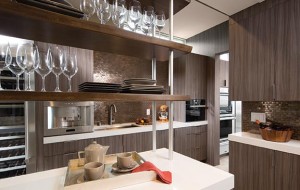
State-of-the-Art Kitchens
For many homeowners, the kitchen is the main hub of household activity, and this was true in TNAH as well.
The home featured several top-of-the-line design and construction features, which can be adapted for both professional and DIY customers working with a wide range of budgets.
Following the same lead as many of the model kitchens on display at IBS and the Kitchen and Bath Industry Show (KBIS), the kitchen in the model home is very modern, with cabinets featuring fine, clean lines for a more simple look.
Another trend Hardware Retailing saw was mixing cabinet finishes, with darker base cabinets accentuating lighter or white upper cabinets.
If your business has a cabinet showroom, it’s imperative that you are constantly changing out your displays to highlight trends like this one. The kitchen display area may be one of the most fashion-driven categories in your LBM department, and customers will always be looking for something new. They may start to overlook displays that haven’t changed for a few years.
Train your showroom sales staff to go after small project sales, too. Communicate to your customers that not all upgrades to the kitchen involve a full remodel. As was evident in the model home, simply adding a metallic backsplash in the kitchen merges the dark and light cabinetry together. This adds to the rich look, and any retailer can help a customer refresh a kitchen with a new backsplash. For the do-it-yourselfer, it’s a project that can be accomplished over a weekend.
Now is also the time to review your tile inventory to keep up with the latest designs. During Design & Construction Week, Hardware Retailing noted that metallic tiles are a growing trend, as are subway tiles, which were featured in several areas at the convention center. Instead of granite countertops, the kitchen in the model home features a quartz surface, which adds to the overall design and also provides function.
If your business offers a variety of countertops, quartz is a great option to sell customers, as it is durable and scratch-resistant. The surface is nonporous, heat- and stain-resistant and doesn’t require sealing.
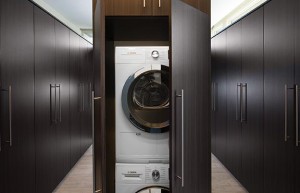
Impressive Walk-In Closets
Today, walk-in closets have become much more than a place to install wire shelving to hang clothes. They’re a sought-after addition to the master suite in both new construction and remodels. In many cases, homeowners create a private dressing room, where beautiful custom cabinets and accessories provide a luxurious space to begin and end the day.
In the model home, the master suite features a large and impressive walk-in closet. The closet features a section built in to hold a stackable washer and dryer unit, a convenient function that appears to be trending even beyond the model home.
At both shows, Hardware Retailing spotted several master bedroom closets with laundry areas built in. It appears as though this trend will continue to grow, and to top off the luxury aspect, homeowners can add unique touches, like a chandelier and even some glass cabinet doors to showcase favorite pieces, like designer handbags and shoes.
In the center of the closet is an island with a countertop for folding clothes and built-in drawers to store items underneath.
While showing model kitchens and baths has been standard in LBM outlets for a long time, it’s time to incorporate luxury closets and laundry rooms into those displays as well.
Then, for those without the space or budget for a large remodel, use this area to encourage small-budget remodels. One trend Hardware Retailing noted at IBS was to add crown molding to the interior of an existing closet. This allows your customer to personalize a closet with an easy DIY project.
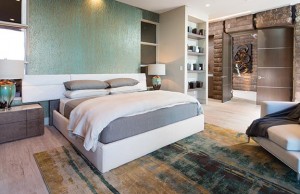 Customization Makes the Home
Customization Makes the Home
Built-in Elements Add to Home
For many homeowners, adding personal touches to the home through customization allows them to express their individuality.
There were many examples of this in the model home. In the master suite, there are built-in shelves next to the bed, which can be used to display books, plants and other items.
Built-in storage units continue to be a hot trend for eliminating clutter for a more open and flowing home.
(Another unique element found in the master suite is a collection of several mini-fireplaces and one large fireplace built into the walls. Although this doesn’t fall into the LBM category, it is another example of how TNAH team wove customization into the home.)
As a retailer, you can take advantage of the trend toward customization by offering your customers educational events, such as project tutorials. For example, host a how-to event to build a bookcase, install shelving or create a custom workbench for the garage with items from your lumber and building materials selection. By inviting customers in to the store to complete a project they may have been putting off doing, you’ll not only engage them with your business and get them to purchase your items to complete the project, but you’ll be able to cast your business as the place to go to learn how a customer can personalize their home in a variety of ways.
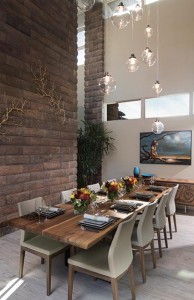
Material Connects Indoors and Outdoors
From brick to siding and more, the exterior of the home is just as important as the interior. In many situations, consumers are looking to mesh these two separate aspects of the home to make it more seamless and connected.
The TNAH project focused on how to blend and match the surrounding Nevada scenery.
The design and construction team made this happen in several ways, including using a stone surface on both the interior and exterior of the home to make a seamless transition between the two heavily used spaces. This unique stone was customized and made to complement the desert backdrop.
According to Bernard, one of the goals of the project was to “blur the interior and exterior divide,” which was in many ways accomplished by utilizing the same stone finish in both areas of the home.
One of the best practices of selling building materials is to use the products you sell in the construction of your own store. Dressing up the exterior and interior of your building with decorative brick and stone will not only allow you to show what your store sells, but it makes it more appealing to a wide range of customers, including female shoppers.
For the do-it-yourselfer who wants an easy way to update the home, at IBS, Hardware Retailing saw a manufacturer that put the look of wood-paneled walls into an easy DIY-sticky application to give the look of reclaimed wood walls without the amount of time required to complete it.

Outdoor Living Increases Square Footage
As a retailer, you’ve heard over the past several years the growing emphasis on outdoor living. Your customers are investing more than ever in outdoor furniture and grills, and indoor comforts are finding their way outside.
Continuing with the trend of blending the interior and exterior space, the designers of TNAH made sure not to waste any of that exterior space.
Many walls of the home open out to the grounds, and large, sliding doors lead to a courtyard that features an infinity pool and spa, wet bar, outdoor kitchen, fire pit and a built-in grill, along with outdoor furniture to complete the space.
Full wall-length sliding doors are a trend you can expect to see, as both were reflected in the model home and at IBS. The outdoor area off the kitchen had a covered terrace, which also included the outdoor kitchen area, featuring a built-in refrigerator and icemaker, as well as a grilling station and storage with single and dual drawers.
Given the continuing trend toward the outdoor room, don’t overlook the cross-merchandising opportunities in grills and outdoor furniture when selling deck materials and sliding patio doors. Also remember that the outdoor room category is one where customers are often willing to pay more for luxury, so don’t be afraid to show high-end items, like outdoor furniture and wet bars.
 Energy Efficiency Is Key
Energy Efficiency Is Key
Save Money with Solar Panels
As more consumers than ever worry about the rising costs of utilities and the impact made on the environment, green building and energy efficiency have become important to homebuilding discussions. This is likely to continue over the next several years, and homebuilders are integrating different energy-efficient products and techniques into the projects they are completing.
The model home featured many green details inside and out. Solar panels on the roof are one of the most notable ways the home achieves energy efficiency.
“The latest green building products and methods are factored into every aspect of the home’s design,” Bernard says. “Green building is a growing trend in the building industry, which TNAH has been promoting since 2000.”
The photovoltaic (solar) panels on the roof allow the home to achieve “net-zero energy”—so the total amount of energy used by the building is about the same amount of energy created on sight, he says.
To tap into this market, you don’t have to limit yourself to selling solar panels. For example, for homeowners who can’t have solar panels on the roof because of neighborhood regulations, solar shingles may be a good alternative to offer.
Adding solar panel options to your store will build a reputation for your business as an environmentally friendly and green retail outlet. Also, remind customers of the tax credits they can get for the purchase of a solar panel, and use this as a selling point showing how they will reduce the overall price of the product.
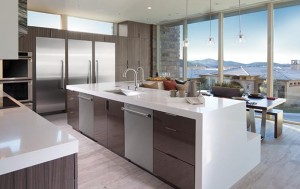
Energy Efficiency With a View
In consumers’ homes, windows can provide a view, allow for natural light and should be energy efficient in construction and design.
While the full-view windows and doors in the model home provide breathtaking views of the Las Vegas skyline, they also meet energy-efficiency standards, Bernard explains.
The large, fixed windows provide ambient sunlight and reduce the need for artificial lighting. The glass in the windows and doors features an advanced Low-E glass coating that blocks the transfer of heat and cold. Low-E glass is glass that is coated with an ultra-thin layer of metal, which allows people to see through it while also providing insulation. Instead of heat bouncing outside after hitting the glass, it bounces back inside.
While the windows in the home are energy-efficient and create great views, the design team had to change their original vision to work best in a desert atmosphere.
The team decided to eliminate some windows from the original design, so most of the windows face northeast. Windows facing south and west have generous overhangs.

Building Materials Keep Homes Energy Efficient
The construction of TNAH brought together many elements to reduce energy usage, and the home has exceeded many energy efficiency building requirements. In addition to using solar energy, the air tightness of its thermal shell is one of TNAH’s most notable features, Bernard adds.
The home used flashing to meet the demands of hard-to-seal corners at windowsills. The insulation increased the energy efficiency and comfort in the home as well as provided air sealing and moisture management and kept out noise. Insulation in the walls and attic and additional sealing products helped maintain consistent temperatures throughout the home.
To view a full photo gallery of the completed model home, click here.
 Hardware Retailing The Industry's Source for Insights and Information
Hardware Retailing The Industry's Source for Insights and Information






